Richard Hamilton of Newbridge.
From Process Server to Petty Sessions Clerk, the story of Richard Hamilton of Newbridge, County Kildare, Ireland
When I started my family history, my g-g-grandfather, Richard Henry Hamilton, intrigued and challenge me. Growing up in a long established Catholic family in Brisbane in the 1950’s and 60’s, I was surprised to find that Richard was a practising member of the Established Church of Ireland and a very devoted one at that.
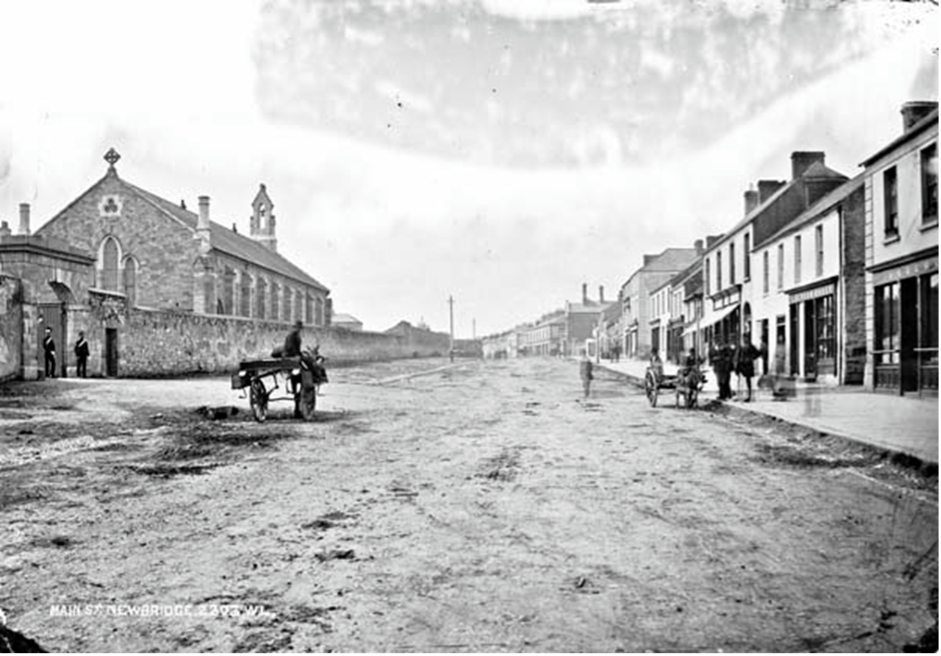
Main Street, Newbridge. Image by: French, Robert, and William Lawrence. Main Street, Newbridge, Co. Kildare. 1865. https://catalogue.nli.ie/Record/vtls000338048
Before Richard Hamilton’s appointment as a Petty Sessions clerk, he was employed as a Process Server for Newbridge, Co Kildare. The first official notice of this appointment was published in the Leinster Express newspaper in February 1838, “constituted and appointed” by Henry Kemmis, Esq., Assistant Barrister for the County of Kildare.[1] He continued in that role as the Process Server for Newbridge until 1860.[2] The names of Process Servers for the county were printed at quarterly intervals in the Leinster Express, announcing the place and date for the Quarter Sessions, which were held at Kildare, Naas, Athy, and Maynooth in turn.[3]
Process Servers, unlike bailiffs, do not act on behalf of the court but in a private capacity although they are responsible for serving legal documents to parties involved in legal proceeding.[4]
In Ireland, at this time, process servers were employed by landlords or the Established Church of Ireland, for arrears in rent or tithes, which would have affected mainly the Irish Catholic small tenant farmer. There are reports in the Irish newspapers that process servers had been attacked or stoned when attempting to serve a process, an occupation not without risk.[5]
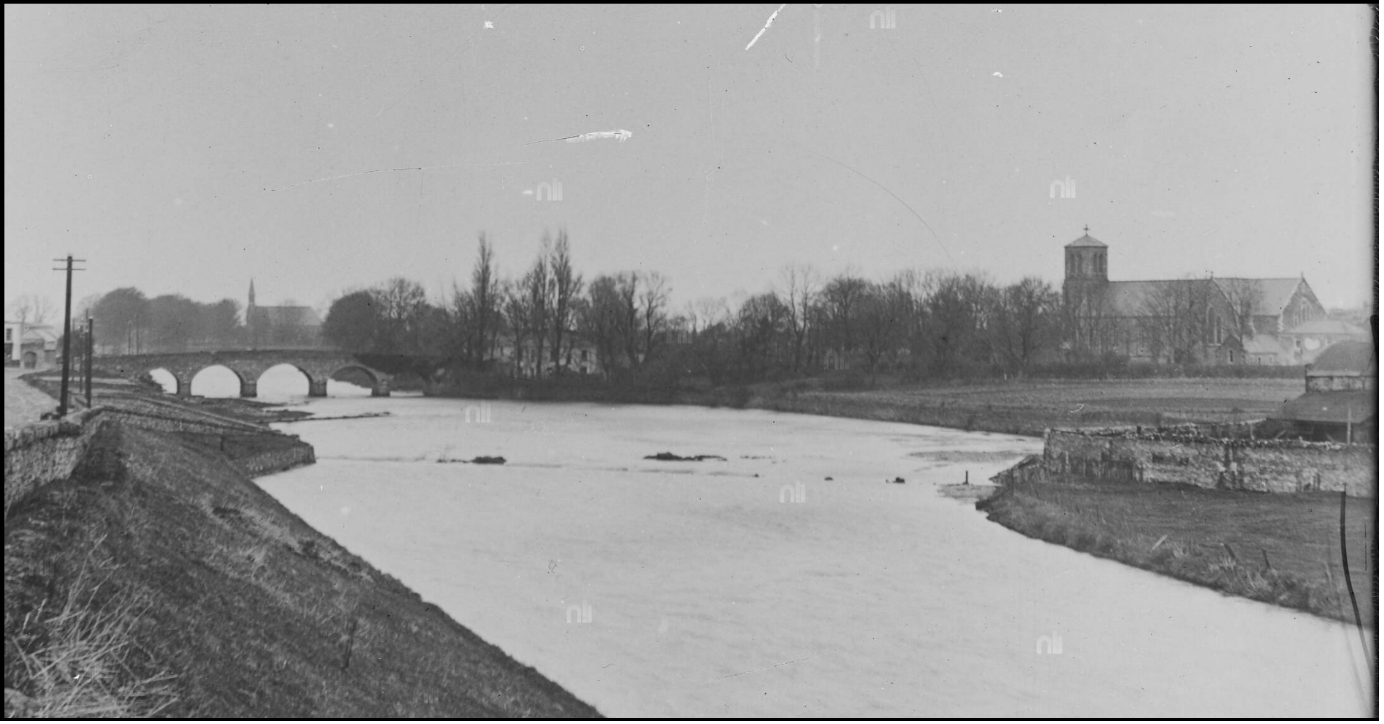
The five arch Bridge over the River Liffey at Newbridge, Co Kildare. Image by: French, Robert, and William Lawrence. Military Barracks, Newbridge, Co. Kildare. 1865. https://catalogue.nli.ie/Record/vtls000319548/HoldingsILS#tabnav
Back in 1837, Samuel Lewis, in his A Topographical Dictionary of Ireland, describes Newbridge, as “a post town and market town”, “of very recent origin and appears to have arisen since the erection of extensive barracks for cavalry in 1816 on land purchased from three landlords in 1822 Eyre Powell of Great Connell, Ponsonby Moore of Moorfield, and William Hannon of Kilbelin” and it is from here that the history of the modern town of Newbridge developed.[6]&[7] Its only street called Main Street was built on the western side of the Liffey River on the route of the mail coach road from Dublin to Limerick crossed by “a handsome stone bridge of five arches, but so narrow that two carriages cannot drive abreast of it. There was a constabulary police station, a dispensary and a Roman Catholic chapel with a friary.”[8]
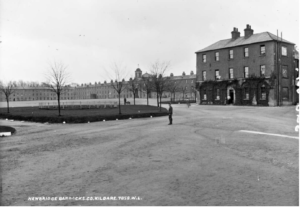
Newbridge Barracks, Co Kildare. Image by: French, Robert, and William Lawrence. Military Barracks, Newbridge, Co. Kildare. 1865. https://catalogue.nli.ie/Record/vtls000319548
Not far from Newbridge is the Curragh, a 5,000 acre “ancient lowland”, which had first been considered as the location for a Cavalry Barrack in the early 1800’s.[9] The Newbridge Railway Station had already opened in 1846 in a location convenient for what was a “temporary” military encampment on the Curragh and Newbridge Barracks, but as the political climate changed in Ireland, it was decided in 1855 to make the Curragh a more permanent military settlement and tents started to be replaced with buildings.
A Petty Sessions Court, opened in May 1858. George Legatte is appointed its first clerk, but within a year Legatte has taken up another position as Clerk for Kildare and Rathangan.[10] Richard Hamilton becomes the next Petty Sessions Clerk for Newbridge and the Curragh, although there is no official notice of his appointment.
In May 1859, Newbridge celebrated the opening of a Town Hall which was used by the Newbridge Gas Company, the Market Committee, Petty Session Court and Town Commissioners Office. It was also the location of the Public Weighing Machine and the Market Place.
On the evening of Tuesday 3rd May 1859, the community celebrated the opening of the new Town Hall.[11] Richard Hamilton was one of those in attendance that night, having established himself as a capable and motivated member of the community, working alongside his landlord, Eyre Powell Esq whom he had known from a young age. Newbridge had expanded rapidly due to the presence of the Military. As well as economic advantages it also bought social problems to the area, referred to as “public nuisances”, described by Charles Dickens in “The Wrens of the Curragh.”[12] It seemed that the condition had become so bad, in the evenings, the streets of Newbridge “were almost impassible, with characters not at all sought for.”[13]
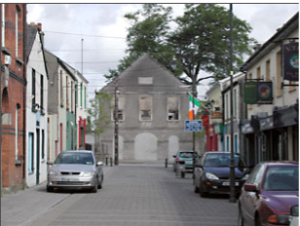
Court House, Eyre St., Newbridge after the fire. Image from: National Built Heritage Service (NBHS) website. Viewed 1 April 2025. https://www.buildingsofireland.ie/buildings-search/building/11818015/newbridge-courthouse-market-square-eyre-street-greatconnell-newbridge-kildare
Could this have been a reason why in 1862, Richard and Catherine Hamilton’s two eldest daughters, Sarah and Eleanor make the decision to leave Ireland, sailing on the Rajasthan for Queensland. Elizabeth joins her sisters in 1866, followed by the Hamilton’s eldest son, Henry with his young family, who sail on the British Lion for Adelaide, South Australia, arriving safely in May 1866 with their two young sons, John born 1862 and Richard Henry Hamilton jnr. in 1865.
On 1 Jan 1865 the Town Improvement (Ireland) Act was passed by the ratepayers of Newbridge at a public meeting held at the Newbridge Court House Newbridge.
Richard was appointed Town Clerk to the Town Commissioner, a position he held in 1868 and 1869, but by the end of that year, landlord Eyre Powell, Esq had died. Richard was “allowed to retire from his position as Town Clerk.”[14] As well, Newbridge itself was facing a new crisis, being so dependent on the Military presence any changes within its structure directly affected the towns economy and the people of Newbridge. This happened in 1870, when the military set up their own canteen, having an immediate and “ruinous effect upon Newbridge as a military settlement.”[15] As a result, a military Court of Inquiry is held at the Curragh Camp on 2 July 1870.[16]
Richard Henry Hamilton, died on the 21 February 1872 at his residence in Eyre Street, Newbridge. He was only 51 years old. His death notice was published in two papers: The Leinster Express and The Belfast Newsletter.[17]&[18]
The local press, the Leinster Express, had nothing to say about Richard Hamilton’s death. There were no comments in the Petty Sessions records after his death or in the Town Commissioners meetings. Life continued and a vacancy for a new Petty Sessions clerk was published on the 6 April, 6 weeks after his death.
As for Richard’s burial and final resting place, it is unknown, as is his birthplace. While his landlord lies at rest in the Old Connell Graveyard, I believe Richard was buried close to Newbridge, in the town that he was so committed to.
In 2015, the only evidence of the Town Hall and Court House was the empty space, named Market Square with a memorial plaque stating that the Court House building was destroyed by fire in 2002.
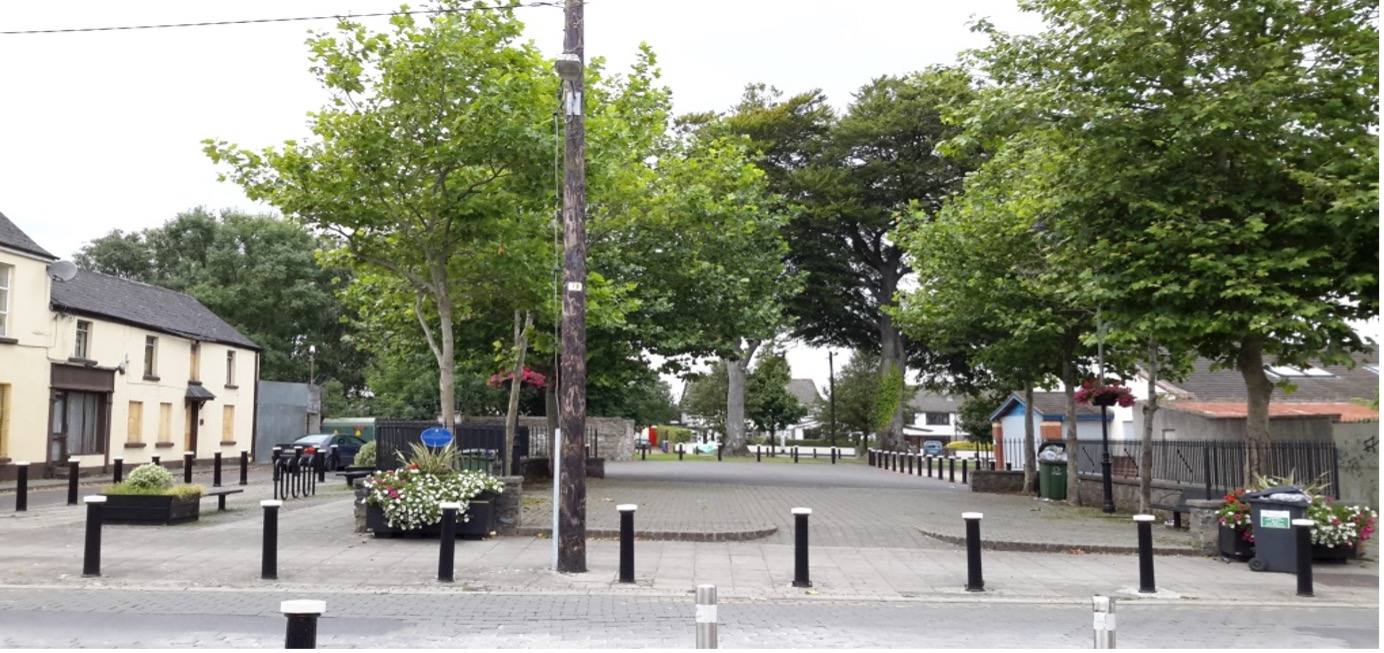
Market Square, only evidence of the old Town Hall and Court House is the empty space and the memorial plaque. Image by author in 2015.
Fire crews fought the blaze at the 150-year-old building for about two hours after it broke out after 6am on April 4, 2002. The roof collapsed within two hours, and it soon became clear that the historic landmark could not be saved. All court cases planned for Newbridge District Court were later transferred to Naas District Court.[19]
[1] Leinster Express 1831-current, 15.02.1851, p1. Source, The Irish Newspaper Archives.
[2] ibid 2.06.1860
[3]ibid, 15.02.1851, p1
[4] Bailiffs and Process Servers. Queensland Courts Website. accessed Mar 2025
[5] Westmeath Independent 1846-current, 31.10.1846, p2
[6] A Topographical Dictionary of County Kildare in 1837. Compiled and edited by: Mario Corrigan, Niamh McCabe and Michael Kavanagh. Published by Local Studies Genealogy and Archives Department Kildare County Library and Arts Services and Kildare Town Heritage Centre, 2008. p113
[7] History of Newbridge-Kildare Local History.ie accessed 01.04.25
[8] A Topographical Dictionary of County Kildare in 1837. p113
[9] https://www.kildareheritage.com/places-in-kildare/the-curragh
[10] Ibid, April 9, 1859, p6
[11] The Freemans’s Journal, May 7, 1859
[12] The Pall Mall Gazette, London, 1867. kildarelibraries.ie/ehistory/the-wrens-of-the-curragh-part-1-1867-original pamphlet/ accessed 2 Apr 2025
[13] Leinster Express, Mar 11, 1865
[14] Ibid, Oct 1, 1870
[15] ibid, Jul 9, 1870, p3
[16] ibid, p3
[17] ibid Feb 24,1872
[18] Belfast Saturday Morning Feb 24, 1872, p1
[19] Memories of destroyed Newbridge courthouse feature in Kildare local history project – Kildare Now

I enjoyed your story about Richard Hamilton thanks Catherine. It prompted me to research the beginnings of the Irish Constabulary (1836). I am intrigued and would like to know something of his character as I am sure you would too. It’s sad fact that his final resting place is a mystery and I assume you are descended from one of his children.
Thanks Bev for the comment. I think we all agree that by writing a blog so much more can be learnt about our families and history. There is more to the story of Richard Hamilton but the blog helped me to begin to explore his life better than I had.